Several grass weeds are associated with sugarcane production in Florida. Sugarcane (Saccharum spp. interspecific hybrids) is cultivated on organic soils in the Everglades Agricultural Area and surrounding mineral soils in southern Florida. Grass weeds reduce sugarcane yield by competing for light, water, and nutrients, causing more economic loss in the crop than other types of weeds. For example, season-long competition of fall panicum with sugarcane can result in up to 60% cane and sucrose yield loss (Odero et al. 2016). Grass weeds left to grow uncontrolled become sources for the soil seed bank and vegetative propagule replenishment, leading to reinfestation in subsequent years. Therefore, grass weeds must be managed appropriately in sugarcane to minimize yield loss.
Proper weed identification is the first step in developing a successful weed management program. Identification of weeds at the seedling stage, early in their vegetative stage of growth when they are most vulnerable to control measures, is important in developing effective management plans.
Grass weeds are monocots; that is, their seedlings emerge as one single leaf. The leaves are narrow with parallel venation and alternate on each side of the stem. The stem is round or somewhat flattened or compressed, and either hollow or solid. Grasses have a fibrous root system. Grasses are classified as annuals or perennials based on their life cycle. Annuals live and produce seed within one year or growing season. Perennials produce vegetative structures or propagules that allow them to live for three or more years, although some also produce seeds. Perennials can be classified as simple or creeping.
This article describes proper identification of grass weed seedlings associated with sugarcane in Florida to assist growers with selecting effective control measures. Identification of grass weeds at the seedling stage before they flower and mature is difficult, but it is important. Control measures based on proper identification cannot be delayed until maturity when most grasses are easy to identify.
Vegetative Parts for Identifying Grass Seedlings
Specific characteristics of parts of the leaf can be helpful in identification of grass seedlings (Figure 1). Important parts include the leaf blade, ligule, auricles, and sheath. The leaf blade is the flattened part of the leaf above the sheath. Hairs can be present or absent on the leaf blade or its margin. The midvein or midrib is the central or principal vein of the leaf. The ligule is the thin, membranous appendage, ring of hairs, or a combination of both on the inside of the leaf at the junction of the blade and sheath. Membranous ligules can have smooth or toothed margins. The ligule is sometimes not present at all in certain grass species. Auricles are small projecting appendages where the blade meets the sheath; these may or may not be present depending on the species. The sheath is the lower part of the leaf that encloses the stem and younger leaves. It is usually either split, united, or overlapping. The juncture of the leaf blade and sheath is the collar. Grass weeds commonly found in Florida sugarcane have split and overlapping sheaths and no auricles.
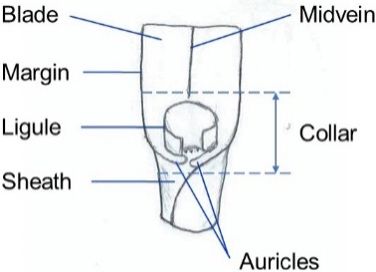
Credit: D. C. Odero, UF/IFAS
The identifying characteristics of 13 grass seedlings commonly associated with sugarcane in Florida are listed below to help with their identification.
Fall Panicum (Panicum dichotomiflorum)
Life cycle: Annual.
Leaf blade: First blade is longer than it is wide and opens parallel to the ground. Blades are 2–3.5 cm long and 5 mm wide. The first few blades are densely hairy on the lower surface. Leaves are rolled in a bud and hairy with a prominent midvein.
Ligule: Fringe of hairs.
Sheath: Hairy on the first few leaves. Seedlings become less hairy with age.
Roots: Fibrous.
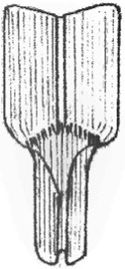
Credit: D. C. Odero, UF/IFAS
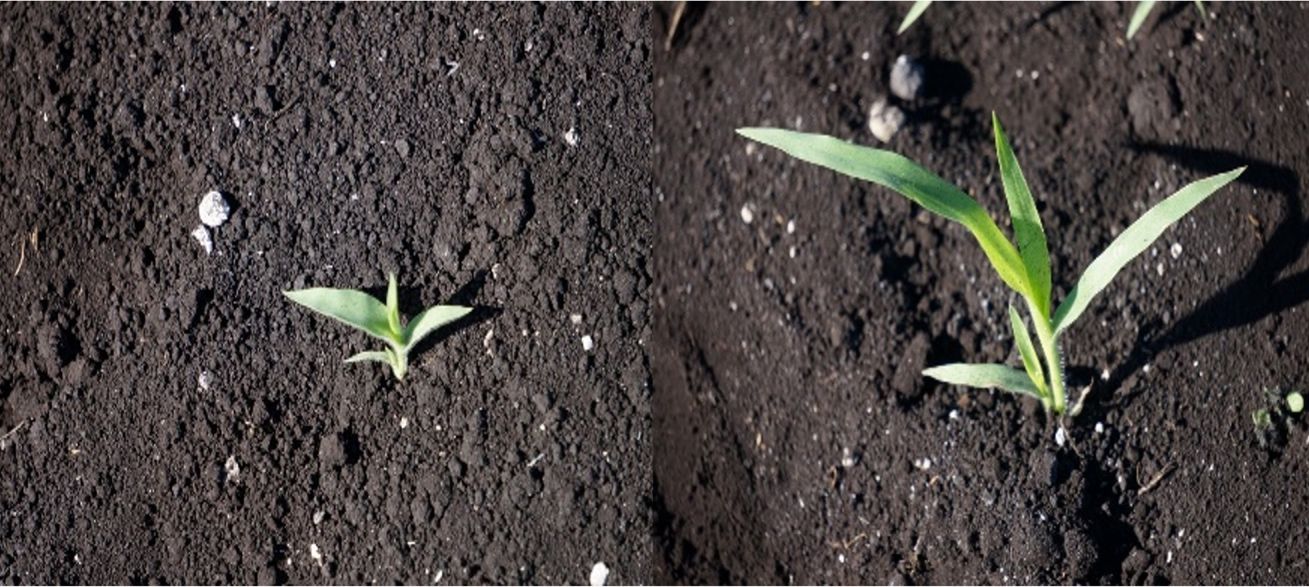
Credit: D. C. Odero, UF/IFAS
Goosegrass (Eleusine indica)
Life cycle: Annual.
Leaf blade: First blade is longer than it is wide and opens parallel to the ground. Blades are 2–4.5 cm long and 3–5 mm wide, smooth, and folded along the midvein. Leaves are folded in a bud.
Ligule: Unevenly toothed membrane.
Sheath: Smooth, prominently flattened or compressed, light green to white at the base.
Roots: Fibrous.
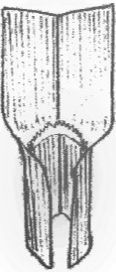
Credit: D. C. Odero, UF/IFAS
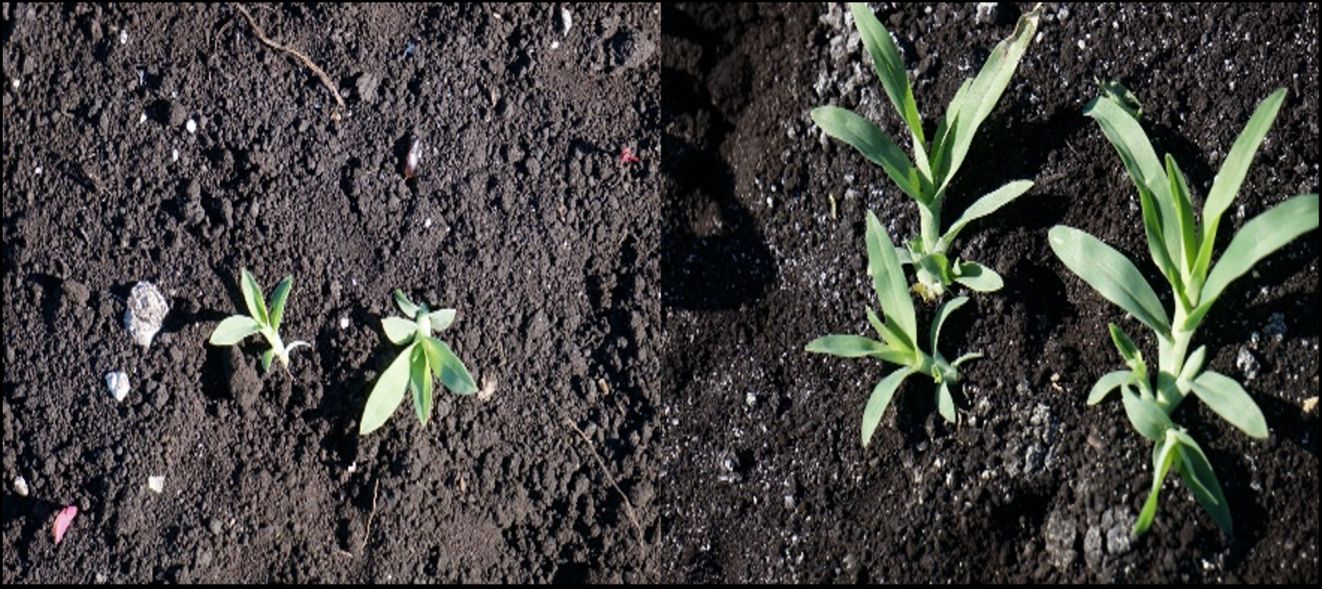
Credit: D. C. Odero, UF/IFAS
Crowfootgrass (Dactyloctenium aegyptium)
Life cycle: Annual.
Leaf blade: First blade is longer than it is wide and opens parallel to the ground; smooth; margin with long, stiff hairs.
Ligule: Membrane with a fringe of hairs at the top.
Sheath: Smooth with long, stiff hairs along the margin. The stem is bending and will root at lower nodes.
Roots: Fibrous.

Credit: D. C. Odero, UF/IFAS

Credit: D. C. Odero, UF/IFAS
Southern Crabgrass (Digitaria ciliaris)
Life cycle: Annual.
Leaf blade: First blade is longer than it is wide and opens parallel to the ground. The blade is only hairy near the collar and is rolled in a bud.
Ligule: Membranous and jagged.
Sheath: Hairy. The stem is spreading, branched, and rooting at nodes, which are hairy.
Roots: Fibrous.

Credit: D. C. Odero, UF/IFAS

Credit: D. C. Odero, UF/IFAS
Southern Sandbur (Cenchrus echinatus)
Life cycle: Annual.
Leaf blade: First blade is longer than it is wide and opens upright. Blades are rough, hairless but sometimes sparsely hairy with long hairs at the base near the ligule, and folded in a bud.
Ligule: Fringe of hairs.
Sheath: Smooth except for fine hairs at the margin, compressed, and often tinged red. Tillers initially ascend but become more prostrate with age.
Roots: Fibrous.
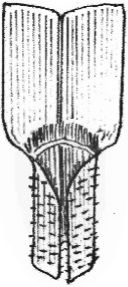
Credit: D. C. Odero, UF/IFAS
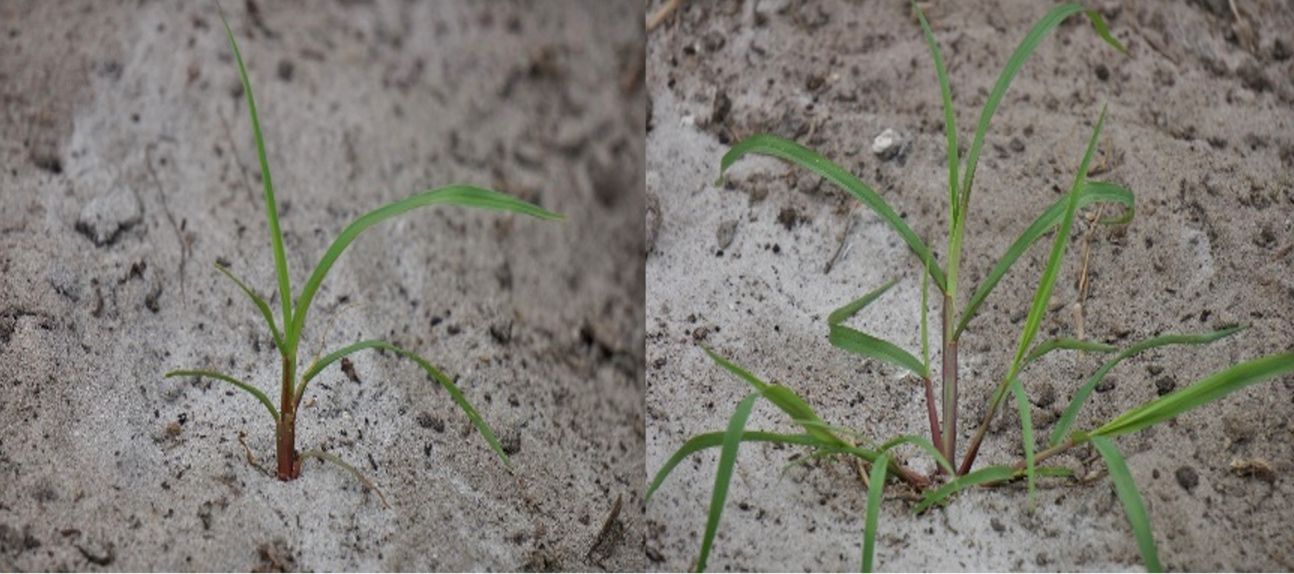
Credit: D. C. Odero, UF/IFAS
Bearded Sprangletop (Leptochloa fusca)
Life cycle: Annual.
Leaf blade: First blade is longer than it is wide and flat. Blades are rough and will be tightly rolled under dry soil conditions.
Ligule: Papery, jagged membrane.
Sheath: Rough.
Roots: Fibrous.

Credit: D. C. Odero, UF/IFAS

Credit: D. C. Odero, UF/IFAS
Coast Cockspur (Echinochloa walteri)
Life cycle: Annual.
Leaf blade: First blade is longer than it is wide and opens parallel to the ground. Blades are smooth and rolled in a bud.
Ligule: Absent.
Sheath: Hairy, somewhat compressed.
Roots: Fibrous.

Credit: D. C. Odero, UF/IFAS
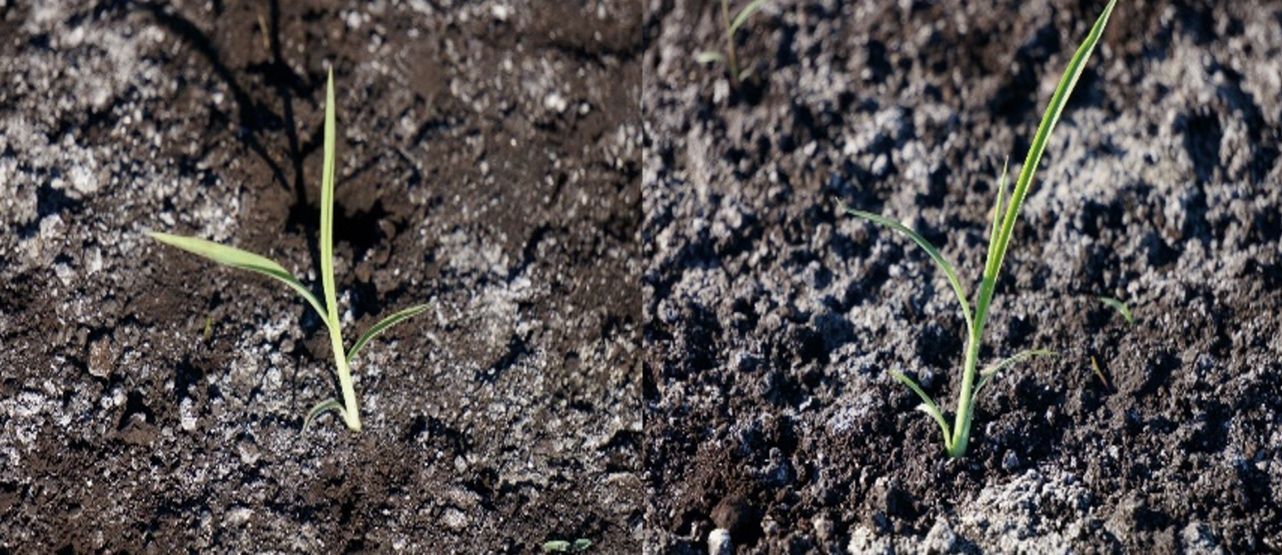
Credit: D. C. Odero, UF/IFAS
Bermudagrass (Cynodon dactylon)
Life cycle: Perennial.
Leaf blade: Smooth, relatively short, narrow, with slightly rough margins, and rolled in a bud.
Ligule: Hairy.
Sheath: Green and smooth. Collars are narrow, white, and smooth on the youngest seedlings only. Older seedlings are hairy.
Roots: Fibrous, rooting at nodes from stolons and rhizomes.
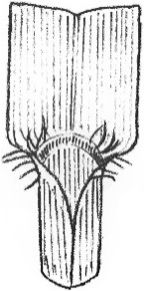
Credit: D. C. Odero, UF/IFAS

Credit: D. C. Odero, UF/IFAS
Columbus Grass (Sorghum almum)
Life cycle: Weak perennial.
Leaf blade: First blade is longer than it is wide and opens parallel to the ground. Blades are rolled in a bud, smooth, and with a prominent midvein.
Ligule: Fringed membrane.
Sheath: Smooth, rounded to slightly compressed, green or with a maroon tinge.
Roots: Fibrous; rhizomes are short and curled at the tip.

Credit: D. C. Odero, UF/IFAS

Credit: D. C. Odero, UF/IFAS
Torpedograss (Panicum repens)
Life cycle: Perennial.
Leaf blade: Stiff, folded, or flat with toothed margin, hairy on the upper surface and margins. Blades are folded and arise from creeping rhizomes.
Ligule: Tiny and membranous with a fringe of hairs on the upper surface.
Sheath: Hairy.
Roots: Fibrous, from creeping rhizomes.
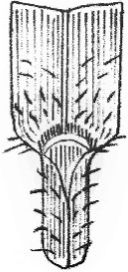
Credit: D. C. Odero, UF/IFAS
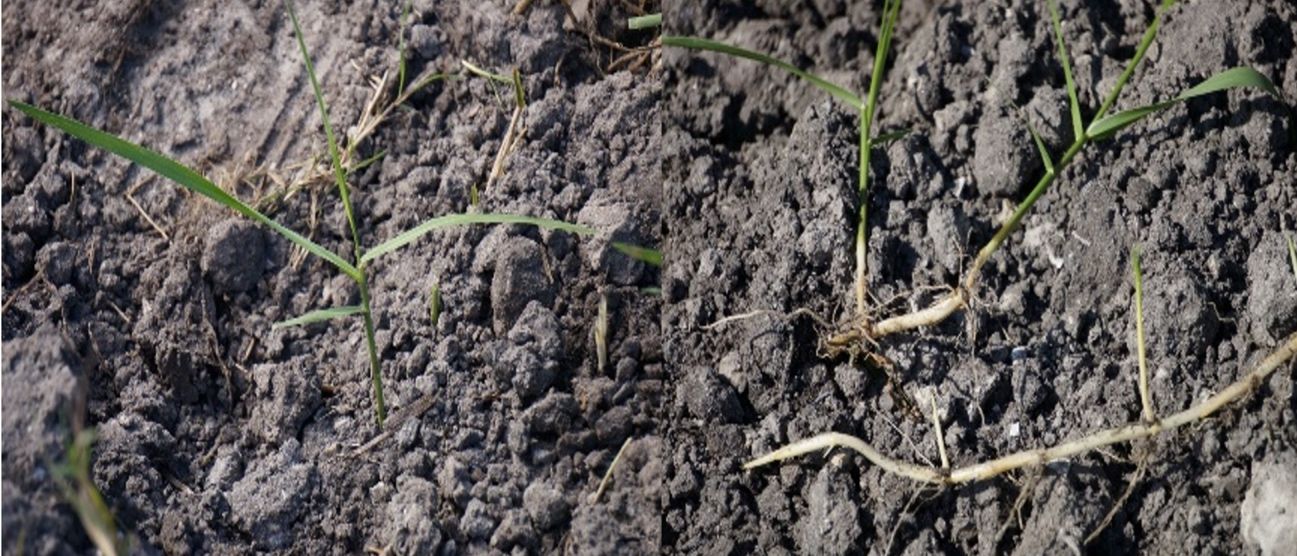
Credit: D. C. Odero, UF/IFAS
Napiergrass (Pennisetum purpureum)
Life cycle: Perennial.
Leaf blade: Flat, covered with long hair near the base, especially on the margins. Blades are rough with stout midvein.
Ligule: Narrow rim densely fringed with hair.
Sheath: Hairy.
Roots: Fibrous, rhizomatous.
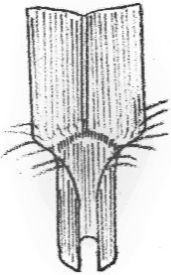
Credit: D. C. Odero, UF/IFAS

Credit: D. C. Odero, UF/IFAS
Reference
Odero, D. C., M. Duchrow, and N. Havranek. 2016. “Critical Timing of Fall Panicum (Panicum dichotomiflorum) Removal in Sugarcane.” Weed Technology 30:13–20. https://doi.org/10.1614/WT-D-15-00091.1